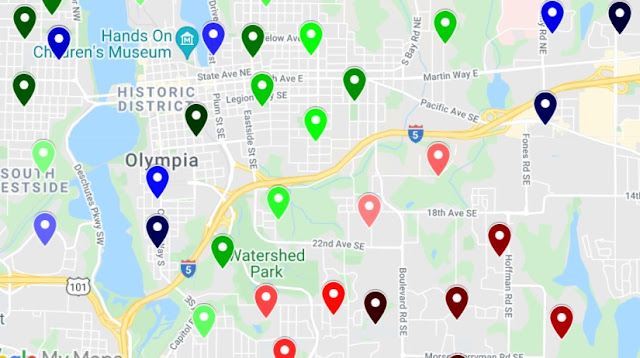Hush Season 2 Premieres on October 8. It will focus on the mysterious death of a 19-year-old in rural western Oregon, in a community very much like the ones you’ll find all along our thin coastal region if you drive out of town for more than half an hour.
According to its co-creator, the amazing Leah Sottile, the new season will use the murder case as a way to explore the decline of local journalism, citizen investigations, and law enforcement. These are nearly universal issues that affect our communities and governments as we struggle to address the most pressing problems we face today.
I have high hopes for this season, largely because I’ve never been disappointed by the work Sottile has been involved in.
But today, I want to focus on Season 1 of the podcast, which centered on the wrongful conviction of Jesse Lee Johnson for the 1998 murder of Harriet Thompson in Salem, Oregon. Hush Season 1 is very much worth the listen. Would recommend.
Salem is a city very much like Olympia. Both are state capitals. While Salem is larger population-wise, Thurston and Marion counties are roughly the same size. You could imagine Salem as a version of Olympia that never spawned Lacey and more aggressively sprawled into the rural suburbs.
Throughout the first season of Hush, you can’t help but hear echoes of the Northwest’s racial past humming beneath it all. The story isn’t just about one man’s decades-long fight against a bad conviction, it’s about how the Northwest’s “white utopia” project still shows up today.
A White Utopia, By Design
Oregon’s founding dream was simple and brutal: keep the state white. The exclusion laws written into the constitution in 1859 made that official. And while the words were eventually removed, the impact never really went away. By 2000, Salem was only 1 percent Black. In fact, the percentage of Black residents had dropped between 1990 and 2000. Johnson himself noted how much he stood out as a Black man in town. That’s not an accident of demographics, it’s the result of generations of deliberate policy.
The podcast frames Johnson’s case as part of the “old plot”: Oregon has a history of turning Black men into villains, whether it was Joe Drake in 1902 or Robert Folks in 1944. Johnson’s trial was just the modern version of the same story. The details change, but the system doesn’t.
Policing to Protect Whiteness
What really sticks out is how quickly police locked onto Johnson—not because the evidence pointed to him (it didn’t), but because in a nearly all-white city, he was the “easy” suspect. One detective even admitted he couldn’t investigate white men the same way, because there were too many of them in the system. Black men? Just a thousand or so.
And when witnesses came forward saying they saw a white man fleeing the murder scene, police shrugged it off. One witness was told flat-out: “A Black person had been murdered, and a Black person was going to pay.” Add in accusations of witness coercion, bribes, and detectives with documented histories of racist remarks, and it becomes clear: bias isn’t just background noise—it’s the whole song.
The Death Penalty as Modern Lynching
Even after all this, Oregon still tried to execute Johnson. Hush doesn’t pull any punches: the death penalty here looks like an evolved form of racial violence. Lynching became the death chamber: different tools, same purpose.
When Johnson’s conviction was overturned in 2023, prosecutors didn’t say he was innocent. Just “not guilty.” That’s a legal technicality, not an apology. Johnson is currently suing the State of Oregon, so he may get a measure of justice under state law. Meanwhile, DNA evidence pointing to other suspects was ignored for years. The state clung to its mistake as if admitting the truth would unravel too much.
The Real Cost
Johnson spent 25 years locked up, most of them on death row. That’s not just time lost—that’s a state deciding the terms of your life, day after day. Oregon has been taking Black lives like this for a long time: sometimes by rope, sometimes by gurney, sometimes just by grinding someone down slowly.
Hush and the Myth of the Northwest
When I first wrote about the claim that the Northwest doesn’t harbor the same racial past or animus as the Dixie South, it struck me how perfectly the name of this podcast captured it: Hush. We don’t talk about this. Whether it’s because of the region’s cultural politeness or something much darker, we get away with acts of racism by staying quiet.
One thing I keep coming back to is the idea that we’ve somehow “moved beyond race.” You hear it in the colorblind rhetoric that took hold about 30 years ago, just before Johnson was convicted, the insistence that if we stop talking about race, the problems will disappear. The trouble is, that story works best for the people it was designed to protect.
The Pacific Northwest wasn’t built on neutrality, it was built on exclusion. Its economy was structured to serve white settlers, and that design still shows up in who holds wealth and power today. When we talk about “moving beyond race,” what we’re really talking about is maintaining the same system, just without having to say the quiet part out loud.
The Northwest likes to describe itself as tolerant, progressive, even enlightened. But that “colorblind” framing is its own kind of blindness. It hides how whiteness has been normalized and protected from the very beginning. If we’re serious about addressing racial inequality, we have to stop pretending we’re beyond it, and start asking who benefits from keeping that myth alive.
Not Hush: Storytelling and Reporting
In her preview of Hush Season 2, Sottile writes painfully about the decline of investigative journalism in the region, citing the demise of Cascade PBS’ long-form and investigative teams. We’ve certainly seen the value of this reporting in Olympia this week.
There’s a lot to say about the decline of newsrooms across the country. It’s a foundational issue for our democracy, and serious people need to start thinking about it soon. Yes, the conviction of Jesse Johnson and much of our regional history happened when reporters were more plentiful. But the question isn’t whether reporters were doing a good job back then. The question is: how do we confront injustice now, in a fractured and undersized media environment?



















